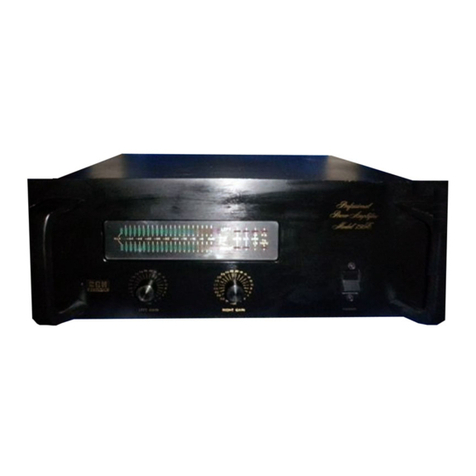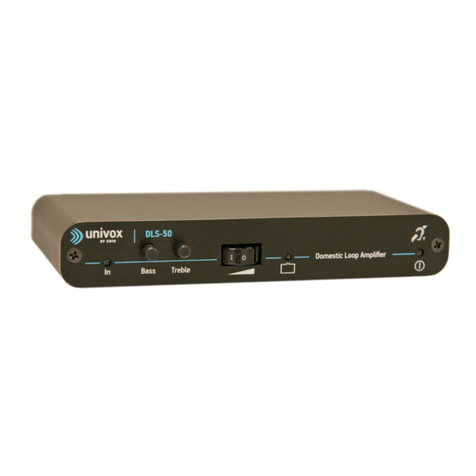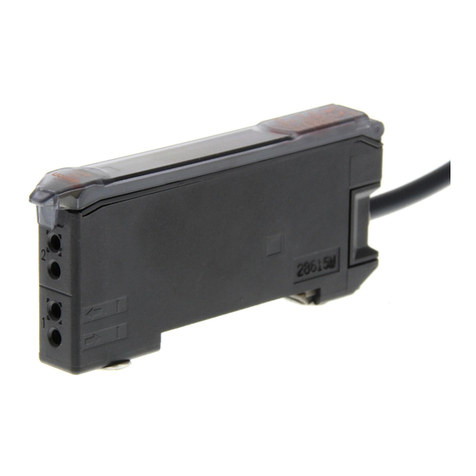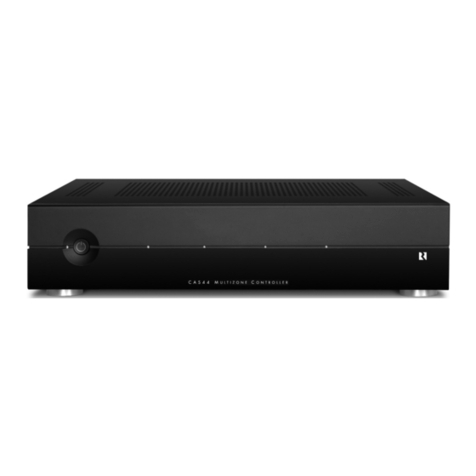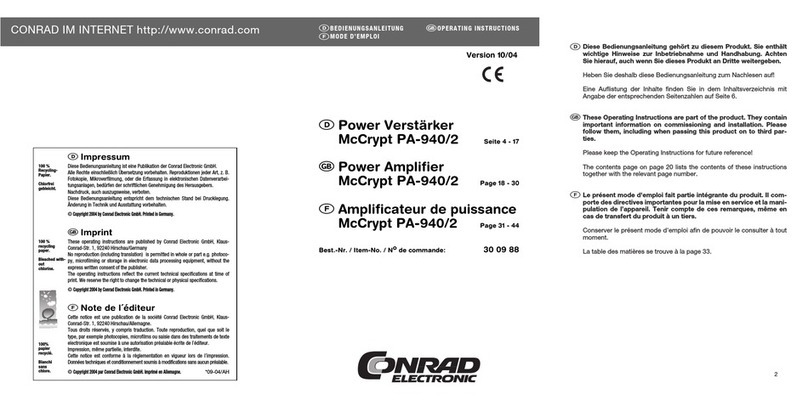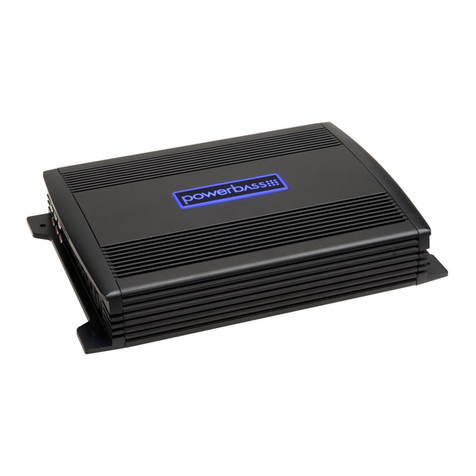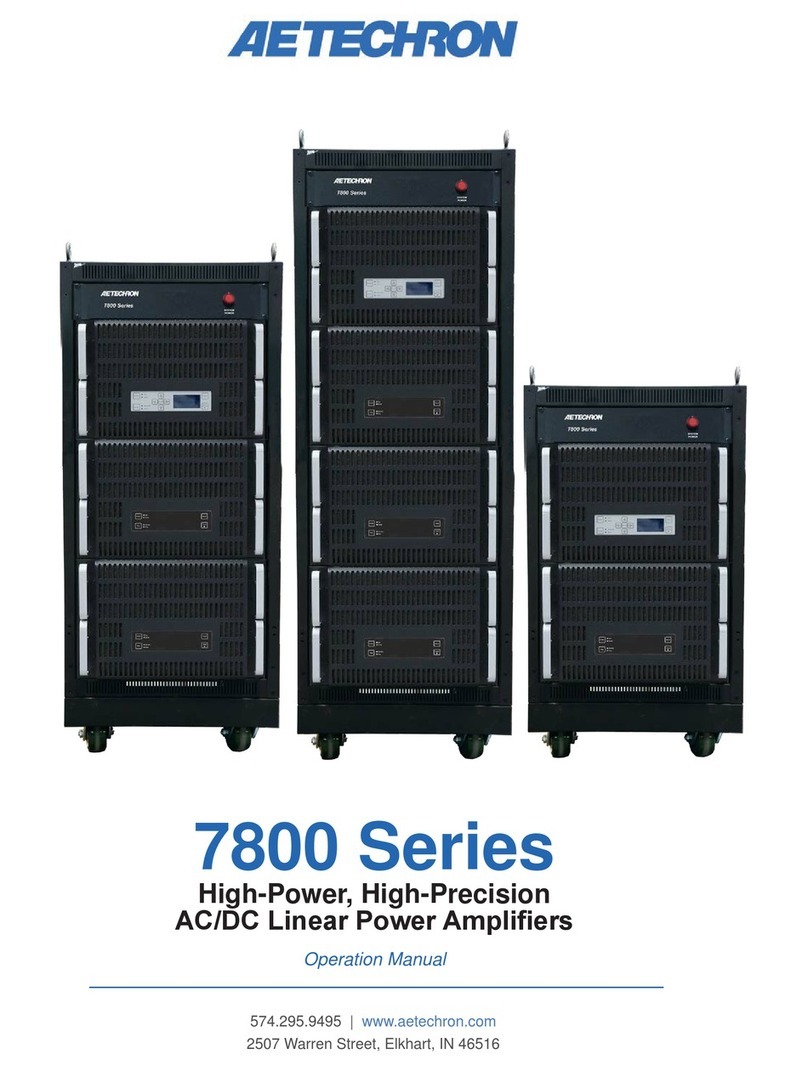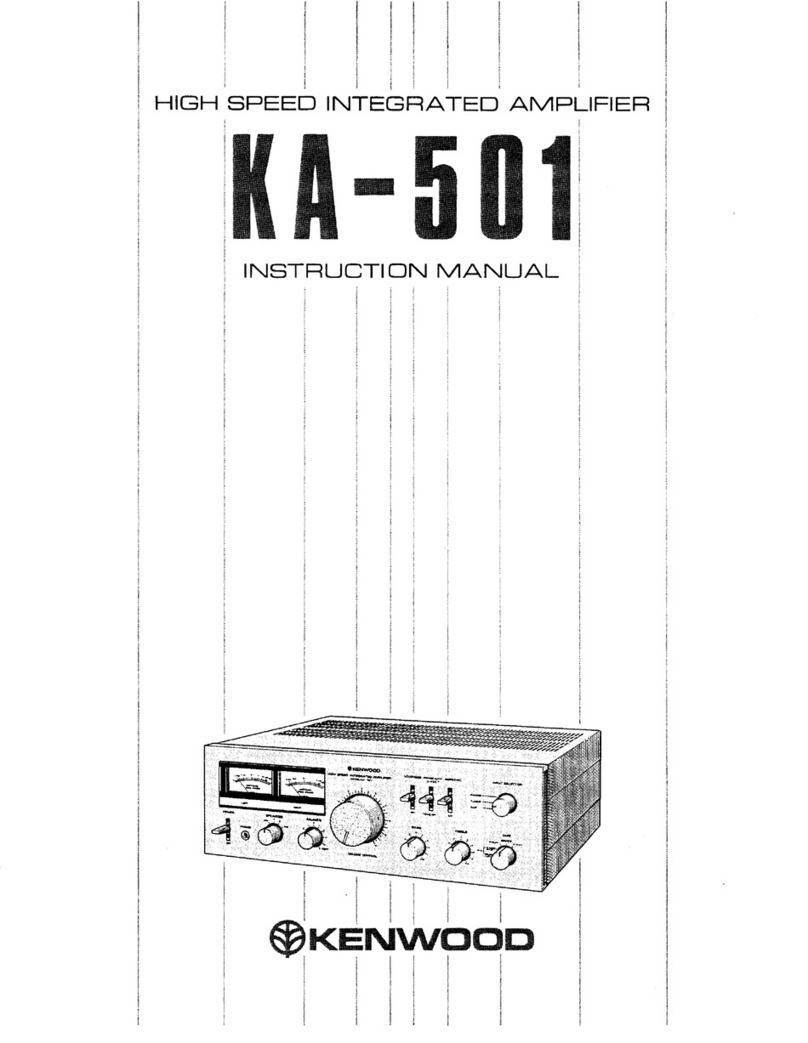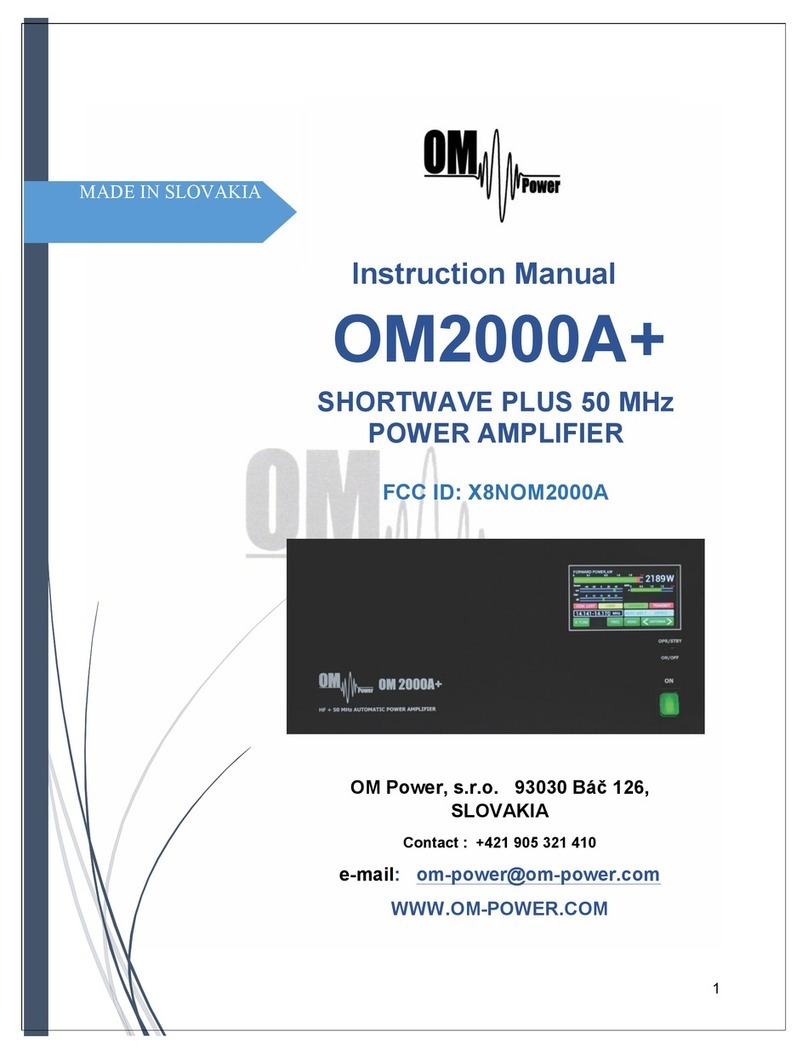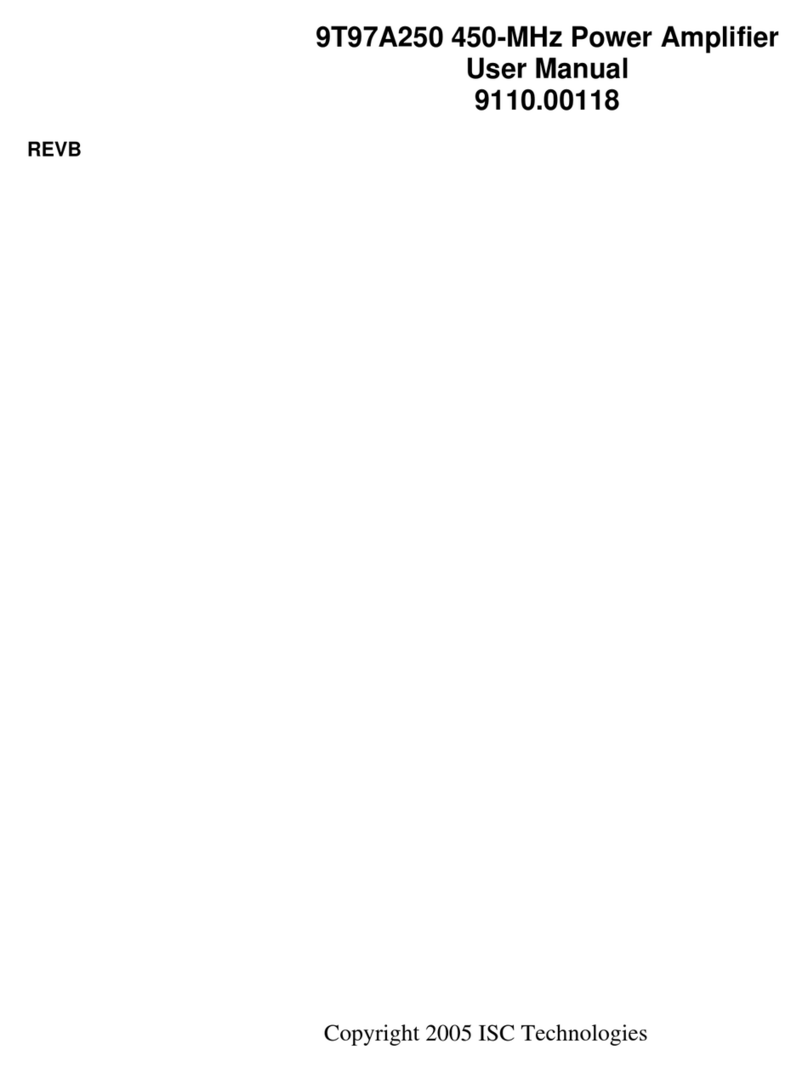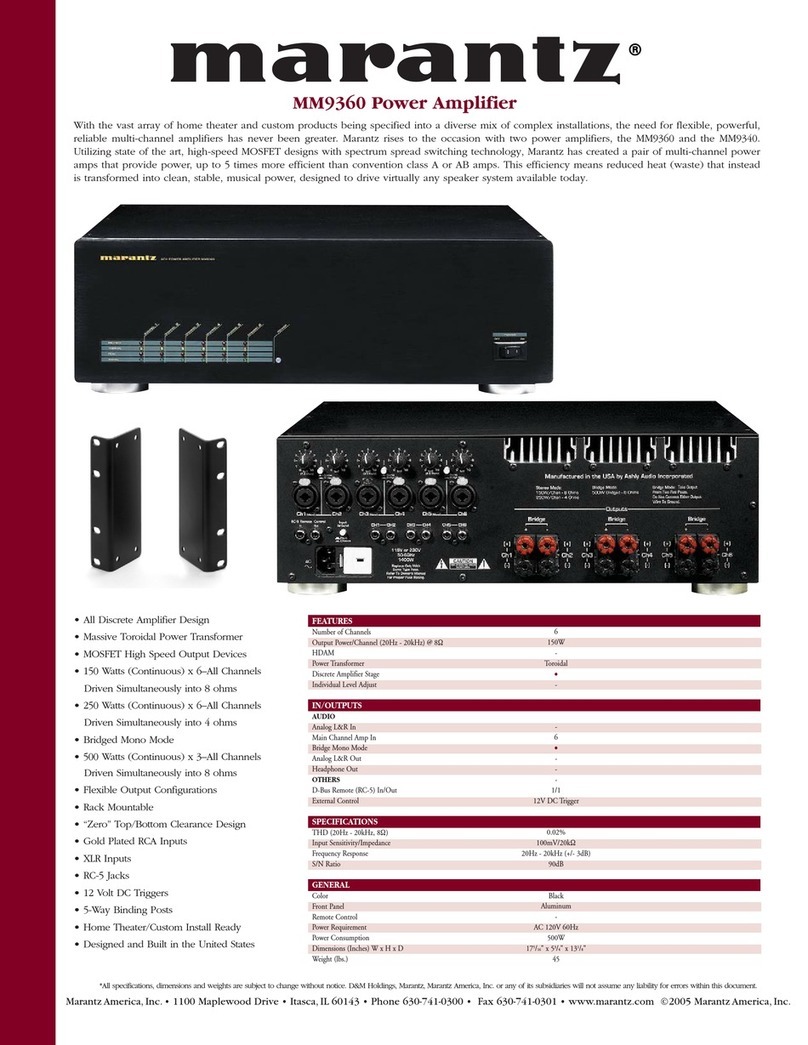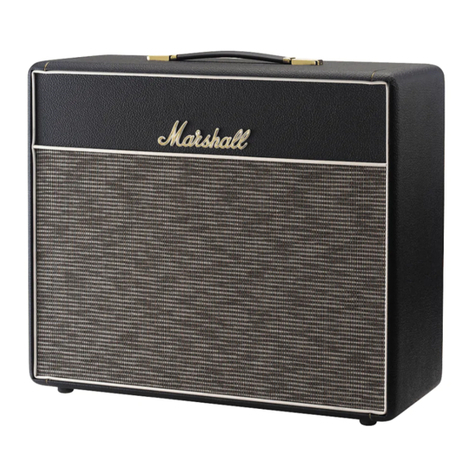BGW 150 User manual

12300-1
!1
SYSTEMS
13130
SOUTH
YUKON
AVe:NUe:
HAWTHO~Ne:.
CAl..lFORNIA
9C250
PHONe:
~
973-8090
Tc!l..EX
NO.
66_4494
(310)
OWNER'S
MANUAL
MODEL
150
PROFESSIONAL
POWER
AMPLIFIER
TABLE
OF
CONTENTS
.FORM
NU~AP,ER
DESCRIPTION
Important
................................
.
.........
..
........
..
. 1)0601
DescriDtion
01530
Specifica
tions
02150
Unp
acking
and
Set-Up
02500
Rack
Mounting
Hints
.............................................
02650
Stereo
Input
Connections
.........................................
03002
Bridging
Balanced
Line
Inputs
.....................................
03011
Bridging
Unbalanced
Line
Inputs
.........................
.
.........
03021
Balanced
Line
Input
.........
......
.
.....
.
......................
. . 03031
U
nbalanced
Line
Input
03041
Terminating
Resistance
Chart
03051
Stereo
Output
Connections
.......................................
0350 l
Damping
Factor
Nomagraph
......................................
03510
Speaker
Fuse'iomagraph
03530
.'vlono
Opera
tion
03650
Power
\
Iains
Connection
ouOOO
Opera
tion
052
00
Circuit
Desc;-iption
..........................
.
...................
123li)
Schematic
Qiagram~
,
-\mplifier
f-leatsink
...
...
.........
...
...
.
....
' .
12
380
Sch
ematic
Qiag!"am,
Chassis
............
,
...
..
..
. .
..
, .
.....
, .
..
,
..
[2371)

12300-2
Schematic
Diagram,
AC
wiring
....................................
12360
Block
Diagram,
Power Amplifier
...................................
12350
Parts
List.
. . . . . . . . . . . . . . . . . . . . . . . . . . . . . . . . . . . . . . . . . . . . . . . . . . . .
..
12390

00601
-IMPORTANT-
PLEASE
READ
THIS PAGE
BEFORE
OPERATING
YOUR
BGW
POWER
AMPLIFtER
Your new
BGW
amplifier
is designed to provide
years
of
trouble
free
performance.
Observing
these
few
precautions
will insure
proper
operation.
All
connections
should be
made
to
the
power
amplifier
with
the
power OFF.
Speaker
fuses should be used
to
afford
maximum
speaker
protection.
Never
connect
the
output
of one
channel
to
that
of
another.
Connect
the
power
cord
to
the
proper
voltage
mains as
indicated
on
the
rear
of
the
amplifier.
ConverSion
to
another
voltage
requires
internal
rewiring.
Do
not
remove
the
amplifier's
cover.
Amplifiers
may
not
be
covered
under
warranty
if
they
are
tampered
with.
There
are
NO
adjustments
within.
Potentially
lethal
voltages
exist
within
the
amplifier.
Refer
all
service
work
to
an
authorized
BGW
service
station.

01530-1
DESCRIPTION
The
BGW
Model
150
is
one
of
the
most
advanced
solid
state,
fully
complementary,
bridgeable,
stereo
power
amplifiers
available.
Features
of
the
Model
150
include
precision
step
attenuator
leve1
controls,
LED
metering,
separate
circuit
and
chassis
grounds,
XLR
and
Y4"
input
connectors
with
transformer
sockets,
and
small
size.
The
front
panel
includes
two
vertical
rows
of
four
red
LED's,
one
row
for
each
channel.
The
lower
LED
in
each
row is
the
IDLE
indicator
or
pilot
lamp.
They
will
be
lit
whenever
the
amplifier
is
turned
on.
The
top
LED in
each
row
is
a
clipping
indicator
and
utilizes
an
exdusive
BGW
circuit.
Whenever
either
channel
of
the
150 is
driven
into
clipping,
a
corresponding
indicator
lights
and
remains
lit
for
0.20
seconds.
These
indicators,
which
actually
indicate
loss of
feedback,
tell
the
operator
that
the
amplifier
is
being
overdriven
and
can
be
invaluable
to
the
engineer
who
must
be
sure
that
every
component
in his
system
is
producing
a
clean,
distortion-free
signal.
An
inadvertant
short-circuited
output
(with
signal)
will
cause
the
LED
to
remain
on
until
the
short
is
removed.
The midd1e LED's
are
connected
to
a
circuit
employing
integrated
circuit
to
provide an
audio
level
indication
of 0.5%
and
50%
of
maximum
power
output.
They
provide a
valuable
tool
for
total
system
evaluation
in
multiple
amplifier
installa
tions.
Both
the
circuit
and
chassis
grounds
are
connected
to
separate
barrier
strip
term
inals on
the
rear
of
the
amplifier.
They
are
connected
together
by a
removeable
link.
By
removing
the
link,
the
circuit
grounds
of
all
active
units
(amplifiers,
preamplifiers,
mixers,
etc.)
can
be
tied
to
earth
ground
at
a
common
point.
This aids in
eliminating
ground
1
00ps.
Ei
ther
XLR-type
of
V4
inch phone plugs
may
be used
for
input
connections.
If
plug-
in
transformers
are
used,
the
XLR-type
connectors
are
connected.
If
not,
jumpers
must
be
employed
in
the
transformer
sockets.
See
sections
03011, 03021, 03031,
and 03041
for
details.
The
size
of
the
\t\odei 150 is
convenient
for
a
wide
variety
of
applications.
However,
please
note
the
following
precaution:
1) Do
not
use
the
front
panel
as
the
sole
support
for
the
am
plifier.
Side
rails
or
rack
sheives
should be
employed
(See
section
02650).
The
output
stages
of your
amplifier
use
the
most
advanced
type
of
transistors
available.
These
large
geometric,
complementary,
power
devices
have
large
safe
operating
areas
and
extended
power
bandwidth.
Electrostatic
and
other
highly
reacti
ve
speaker
systems
present
no
difficulties
for
the
.\"odel 150. The
aluminum
heat
sinks
are
located
so
the
150
power
amplifiers
can
be
stacked
on
top
of
each
other
and
air
can
be
forced
through
both
sides
to
cool
the
products.

01530-2
AU of
the
semiconductors
in
the
output
area
are
in
intimate
contact
with
the
heat
sink. The bias
circuit
is also
mounted
on
this
isotherm
to
provide
rock
steady
bias
stability
with
temperature.
The
voltage
gain
circuits
are
also
mounted
on
the
same
circuit
board.
A
true
operational
amplifier
integrated
circuit
acts
as
the
front
end.
The
op-amp
is a
special
unit
featuring
very
low
noise,
high
speed
(lOMHz). The
op-
amp
stage
is followed by a
discrete
complementary
pair
acting
as
an
active
current
source/sink
and providing
voltage
gain. The
current
source
is
the
ideal
way
to
drive
the
output
stage,
which is
basically
a
triple
Darlington
voltage
follower.
This
sophisticated
circuit
design
makes
for an
extremely
accurate
amplifier.
The
accuracy
of
an
amplifier
is a
function
of
the
ratio
of
the
open
loop
gain
to
the
closed
loop
gain.
In
this
case,
the
open
loop
gain
is
about
1,000,000. This
extremely
accurate
signal
processing
enables
the
amplifier
to
drive
speakers
at
very
high
levels
while adding
absolutely
no
coloration
of
its
own. Even
at
milliwatt
levels,
the
output
waveform
exhibits
no sign of
crossover
distortion.

02150-1
THE
BGW
150
PROFESSIONAL
POWER
AMPLIFIER
Exacting
design
standards
and
unique
features
establish
the
BG
W
ampJifier
as
the
industry
leader
in
power
amplifier
technology.
Features
such
as
all
steel
chassis
and
covers,
metal-case
output
uansistors
and
totally
modular
construction,
have
set
the
industry
standard
in audio
power
amplifiers.
Delivering
a full 50
watts
per
channel
into
8 ohm
loads
and using
the
latest
in full
complementary
circuitry
techniques,
the
Model 150
offers
reliability
and
performance
unparalleled
in
the
industry.
SPECIFICA
TIONS:
BG
W
MODEL
150
OUTPUT
POWER
50
watts
minimum
sine
wave
continuous
average
power
output
per
channel
with
both
channels
driving
8 ohm loads
over
a
power
band
from
20Hz
to
20kHz.
The
maximum
Total
Harmonic
Distortion
at
any
power
level
from
250-milliwatts
to
50
watts
shall be
no
more
than
.05%.
75
watts
minimum
sine
wave
continuous
average
power
output
per
channel
with
both
channels
driving
4 ohm
loads
over
a
power
band
from
20Hz
to
20kHz.
The
maximum
Total
Harmonic
Distortion
at
any
level
from
250-milliwatts
to
75
watts
shall be no
more
than
.08%.
150
watts
minimum
sine
wave
continuous
average
power
output
monaural
driving
an 8 ohm load
over
a
power
band
from
20Hz
to
20kHz. The
maximum
Tota
l
Harmonic
Distortion
at
any
power
level
from
250
milliwatts
to
150
watts
shall be
no
more
than
.08%.
*All
specifications
and
features
are
subject
to
change
without
notice.

Intermodulation
Distortion:
Small Signal
Frequency
Response:
Hum and Noise
Level:
Input
Sensitivity:
Input
Impedance:
Damping
Factor:
Output
Impedance:
Power
Requirements:
Semiconductor
Complement:
Dimensions:
Weight:
02150-2
SPECIFICATIONS
Less
than
0.0296
from
250
milliwatts
to
rated
power.
+0, 3dB, 1Hz
to
100kHz,
+0, 0.25dB,
20Hz,
to
20kHz.
Better
than
102dB
below
50
watts
(unweighted,
20Hz
to
20kHz).
1.0
volts
for
maximum
power
output.
Voltage
gain
26dB (20
times).
15K
ohms.
Greater
than
400
to
1.
Referenced
at
8
ohms
at
1kHz.
Designed
for
any
load
impedance
equal
to
or
greater
than
4
ohms.
100, 120, 200, 220
or
240
volts
50-60Hz
350
watts.
2
Ultra-low
noise Op Amp IC's, 2
level
detector
Ie's,
2
delay
timer
IC's, 26
transistors,
4
zener
diodes,
12
diodes,
8
LED's.
1
3/4"
by 19"
standard
rack
front
panel.
Depth
behind
front
panel
11Y2".
(4.45cm
X 48.26cm X
29.21cm).
14
lbs. (6.37 kg)
net,
l8 Ibs (8.18 kg)
shipping.

02500
UNPACKING
A.t\fD
SET-UP
Your
8GW
Power
Amplifier
is
shipped
in
an
advanced
packing
container.
SAVE
THE
CONTAINER
AND
ALL
PACKING
MATERIAL!
The
container
should
be
saved
in
the
event
the
unit
is
moved
or
shipped
at
some
future
date.
Replacement
containers
are
available
from
BGW
Systems
for
$14.00,
freight
included.
Inspect
the
unit
for
damage
in
transit
immediately
upon
re-
ceipt.
If
damage
is
found,
notify
the
transportation
company
immediately.
Only
the
consignee
may
institute
a
claim
with
the
carrier
for
shipping
damage.
8GW
will
cooperate
fully
~n
such
event.
Be
sure
to
save
the
container
as
evidence
of
damage
for
the
shipper
to
inspect.
The
amplifier's
mounting
position
must
be
chosen
carefully
so
that
the
air
flow
to
the
sides
of
the
unit
is
not
restricted.
Inadequate
ventilation
may
cause
the
prot"'ecti',e
heat
sensors
to
shut
the
~nit
off.
For
rack
mounting,
the
four
rubber
feet
on
the
bottom
of
the
unit
may
be
removed
and
no
hardware
will
be
loosened
inside
the
unit.
DO
NOT
PLUG
THE
AMPLIFIZR IN YET!
All
connections
should
be
made
before
power
is
applied.

02650
RACK
MOUNTING HINTS
KEEPING IT
COOL
A
power
amplifier
draws
energy
from
a
primary
electrical
service,
usually
a 120
VAC
outlet,
to
drive
loudspeaker
systems
with
an audio
signal.
Typically,
only
half
of
the
energy
can
be
delivered
to
the
loudspeakers;
remaining
energy
is
converted
into
heat,
and
must
be
dissipated
(ventilated)
into
the
air.
Air
circulating
past
heat-producing
components,
absorbs
the
heat
and
carries
it
away.
To
accomplish
this,
low and
medium
power
amplifiers
rely
on
natural
convection
currents,
while
most
high
power
amplifiers
use
fans.
If
the
air
flow is
impeded,
the
resulting
rise
in
heat
may
cause
an
amplifier
to
stop
working
or
fail.
Circulating
air
currents
must
not
be
cut
off
when
installing
power
amplifiers
in
racks.
Power
amplifiers
using
convection
cooling
require
spacing
between
amplifiers
to
permit
air
flow
between
them.
Power
amplifiers
using
forced-air
cooling,
on
the
other
hand,
can
usually be
stacked
closer
to
each
other
and
may
not
need
any
blank
panel
spacing
between
amplifiers.
To
improve
natural
convection
currents
within
a
rack,
a
chimney
can
be
created
by
closing
the
back
of
the
rack
and
venting
the
rack
at
the
bottom
to
let
in
fresh
air,
and
at
the
top
to
exhaust
hot
air.
Vents should be
large
rectangular
slots
approximately
19" wide by
4."
high.
The
rack
cabinet
will
require
some
type
of
blower
if a
large
air-flow
is
required.
It
is
best
to
exhaust
air
from
the
top
of
the
rack
rather
than
to
blow
it
in
from
the
bottom.
There
will be
less
dust
and
dirt
in
the
rack
this
way, if
the
bottom
vent
is
sufficiently
large.
INSTALLING THE UNITS
Use
care
when
mounting
equipment
in
a
rack.
Place
the
heaviest
units
near
the
bottom
of
the
rack
and
fill in all unused
rack
spaces
with
blank
panels.
Equipment
cannot
always
be
supported
by
front
panels
alone.
This is
especially
true
of
amplifiers
whose
depth
is
more
than
twice
their
height.
Uniform
support
can
be
insured
by
instaUing
bottom
or
side
rails.
When
racks
are
to
be
transported
or
used in a
mobile
installation,
some
means
of
securing
the
rear
of
the
equipment
are
required.
Angle
brackets
either
attached
to
the
bottom,
side
rails
or
rear
panel
are
practical
approaches.

03002-1
STEREO INPUT CONNECTIONS
Three-pin
XLR and
}1.
in. phone jacks
are
provided
on
the
rear
of
the
amplifier
for
inpult
connections.
Balanced
or
unbalanced
lines
may
be used;
however
if
input
cables
are
longer
than
8
feet,
balanced
lines
may be
necessary
to
maintain
the
signal-to-noise
ratio and high
frequency
response.
1/4-
INCH PHONE
JACKS
The
114"
phone
jacks
are
for
unba
l
anced
lines
only (single
conductor,
shielded)
and
may be used
directly.
Simply
connect
the
shield
to
the
outer
sleeve
of
the
plug and
the
inner
conductor
to
the
tip,
or
buy
ready-made
cables.
See
diagram
below.
CONNECT SHIELD
HER~'-
JJ
-r
~
t 10
CONNECT
INNE!
CONDUCTOR
HERE SLEEVE TIP
"
3-PIN XLR
CONNECTORS
The 3-pin XLR
connectors
may
be used
with
balanced
(2-conductor,
shielded)
or
unbalanced
lines. They
are
connected
to
the
amplifier's
inputs
by using
the
8-pin
transformer
socket;
they
cannot
be used
directly.
Unbalanced
Lines
To use
the
3-pin XLR
connectors
with
unbalanced
lines,
a
jumper
plug
(BGW
PiN
1350-0108)
must
be
inserted
into
each
transformer
socket.
The
jumper
plug
connects
pin
III
to
pin
117,
and pin
116
to
pin
118
as
shown.
With
the
jumper
plug
in
place,
the
3-pin
XLR
connector
has pin
JUMPER
PLUG #2
connected
"to
MUST BE USED
ground,
and pin
113
to
WITH
the
input
of
the
UNBALANCED
amplifier.
Note:
Rear
LINES of plug shown.
When using single
conductor
shielded
cable
for
unbalanced
lines,
connect
the
inner
conductor
to
pin
1/3
and
the
shield
to
pins
111&
112.
J--~
When using
2-conductor
shielded
cable
for
unbalanced
lines,
connect
the
high
level
signal
wire
to
pin
113,
the
low
level
signal
wire
to
pin
112,
and
the
shield
to
pin
Ill.
Note:
Shield not
connected
to
anything
at
signal
source.

03002-2
To
achieve
a
true
balanced
input,
it
is
necessary
to
use one
transformer
for
each
input.
These
should be plugged
into
the
octal
sockets
provided.
Depending
on
the
specific
application,
one
of
several
different
transformers
may be
selected.
Forms
are
included
in
this
manual
to
help
guide
you in your use and
selection
of
transformers.
Use
the
index below
to
find
the
appropriate
form
to
match
your
needs.
CONNECTING
ON
SOURCE
TO ONE AMPLIFIER
Using
Balanced
Lines:
Refer
to
form
1103031
Using
Unbalanced
Lines:
Refer
to
form
110304-1
CONNECTING ONE SOURCE TO
TWO
OR
MORE AMPLIFIERS
OR
DEVICES
Using
Balanced
Lines:
Refer
to
form
1103011
Using
Unbalanced
Lines:
Refer
to
form
1103021
NOTE:
Each
amplifier
input
will be
referred
to
as
the
"Load"
in
the
above
mentioned
forms.
Only one
channel
will be shown.
Two
conductor
shielded
cable
should be used in a
balanced
line
system.
Connect
input
cables
as shown below.
Pin If1 Shield (Ground)
Pin
{"2
Signal (Minus)
Pin
113
Signal (Plus)
-"~
}I-L.,.=::::::!-~-
3
FOR
MONO (BRIDGED) OPERATION
To
operate
the
unit
as
a mono
amplifier,
use
the
left
channel
input
only. DO NOT
use
the
right
channel
input.
Remember
to
place
the
stereo/mono
switch
in
the
mono
position.

I
r(
load
112
03011
BRIDGING BALANCED LINE INPUTS
Used only when
two
or
more
devices
are
driven
from
the
same
input
line.
r-,
3
I
600 ohm 2 W 1 I
SOURCE 1
r---!
r<
D
~
I--
)
~
1000-
load I load
III
liN
MAXIMUM NUMBER
OF
AMPLIFIER
25ea
Input
transformers
for
above
A.
Use
1:
1
transformer
600 ohms
to
600 ohms
B.
Nth
load
must
have
a
terminating
resistor
added
to
the
secondary
of
the
Input
transformer.
r
One
alternative
configuration
is
.
C.
l:
1
transformer
15K ohms to 15K ohms
D. Nth load
must
have
a
terminating
resistor
added
to
the
primary
of
the
input
transformer.
To find this
resistance
value
see
sheet
TERMINATING RESISTANCE
CHART,
MFRM 03051.
NOTE:
Terminating
resistance
is
required
when
source
is
a
transformer.
Sources
other
than
a
transformer
may
not
need
a
termination.

03021
BRIDGING UNBALANCED LINE INPUTS
Used only when two
or
more
devices
are
driven from
the
same
Input
line.
600 ohm
HI
.
~~------~------------~--------~
SOURCE
LO
load
111
load
112
load
liN
The Nth load should have a
terminating
resistor
added to
its
octal
plug
between
pin 1 and pin 6.
To find this
resistor
value
see
sheet
"TERMINATING RESISTANCE CHART",
MFRM 03051.
NOTE:
Terminating
resistance
is required when
source
is a
transformer.
Sources
other
than
a
transformer
may
not
need a
termination.

03031
BALANCED LINE INPUT:
Used only when one
amp~ifler
is driven from one
source.
600 ohm / _'
-,
.....-....
\ } ( )
LOAD
Source -I
Input
transformer
for
above
A.
Use 1:5
transformer
600 ohms
to
15K
ohms
NOTE:
No
600
ohm TERMINA
nON
IS
REQUIRED
B.
Alternate
transformer
Use 1:!
transformer
600 ohms
to
600 ohms
NOTE:
600
ohms
termination
is required on
the
secondary of
the
transformer
NOTE: Terminating
resistance
is required when source is a
transformer:
sources
other
than a
transformer
may not need a termination.
600
ohm
termination,
when required, can
be
accomplished
by
soldering
the
resistor
across pins 1 and 6 of
the
transformer
as shown below
600
6HMS
or
by
installing
the
resistor
in
a 1/4" phone plug and inserting
it
into the unused
unbalanced input jack.

03041
UNBALANCED LINE
INPUT
Used only when one
amplifier
is driven from one
source
600 ohm 1
.....
\ ,
.......
\
LOAD
\ I
\
-'
-.
Source
A 600 ohm
terminating
resistor--
must"
be
added to its
octa!
plug.
Between pin 1 and pin 6
NOTE: Terminating
resistance
is required when
source
is
a
transformer.
Sources
other
than a
transformer
may
not
need a
termination.
600 ohms

03051 ·
TERMINATING
RESISTANCE
CHART
How
to
find
terminating
resistance
for
balanced
or
unbalanced
600
ohm
lines,
driving
more
than
one
amplifier.
STEP
A
*Input
Impedance
of
Amplifiers
=
Total
Load
Impedance
Number
of
Amplifiers
of
Amplifiers
STEP
B
Total
Impedance
of
Amplifiers
-600 K
(Impedance
=
Factor)
600
STEP
C (
t+~
x 600 ohms = Load
Resistor
Required
EXAMPLE:
Input
Impedance
of
Amplifiers
=
15,000
ohms
Number
of
Amplifiers
= 4
A
1~,000
= 3750 ohms
B
3750-600
600 =
5.25
1
C
5.25
+1
x 600 =
1.19
x 600 =
714.29
ohms
Closest
value
is
715 ohms
1%
metal
film
resistor.
* Note
all
amplifiers
must
have
the
same
input
impedance.
If
not,
use
formula
below:
i =
Total
Load
Impedance
EXAMPLE:
Four
(4)
Amplifiers
with
input
impedance
of
15k,
30k,
30k
and
7.5k
1..
= 3750 ohms
I
\ \
'-t
IS'(.
+
30~
+
30K
-7.SK.

03'01-1
STEREO
0UTPUT
CONNECTIONS
Two
sets
of
five-way
binding
posts,
on
the
rear' pane!,
serve
as
output
connectors,
with
one
black
and
one
red binding post
fOl"
eadl
channel.
Left
channel
leads
go
to
the
blnding posts
marked
LEFT;
right
channel,
to
those
marked
RIGHT.
Output
leads
are
best
connected,
to
the
amplifier,
with
standard
banana
plugs;
however,
the
five-way
action
of
the
binding posts
permits
the
use of tinned wires
or
spade
lugs.
Make
certain
that
the
speakers
are
properly
phased.
Connect
the
black
or
minus (-)
terminal
on
the
speaker
cabinet
to
the
appropriate
black binding
post
on
the
amplifier.
Connect
the
red
or
plus
(+)
terminal
to
the
red
binding post.
Check
to
see
that
the
stereQ-mono
switch
on
the
rear
of
the
amplifier
is in
the
stereo
position.
SPEAKER PROTECTION
All
speakers
can
be
damaged
by
having
too
much power
applied
to
them.
Fuse
protection
is an
effective
-
and
inexpensive
way
of
preventing
this
from
occurring.
Ii
your
speaker
system-does
not
contain
a
fuse
or
a
circuit
breaker,
a fuse should be
placed
in
series
with
each
speaker
and
the
wire
going
-~o
the
red
terminal
on
the
rear
of -
the
amplifier'•.--
Maximum
protection
can
be
obtained
with
fast-acting
fuses.
-Use
the
value
recommended
by
the
manufacturer.
Ii
no value is
specified,
use
the
chart
provided
to
select
the
correct
value
(MFRM-03530).
To
use
the
chart,
take
a
straightedge,
such
as
a
ruler,
and
line
up
the
speaker's
impedance
with
its
peak
music power
rating.
The
proper
fuse
value
can
then
be
read
from
the
center
column. Choose a
fuse
that
is
closest
to,
and below,.
the
value
indicated.
.
WIRE SIZE AND DAMPING FACTOR
The high damping
factor
ot
BG
W
ampiiiiers
results
in
a very
dean
bass
response.
Excessively long,
and
small
diameter
speaker
wires
can
lower
the
damping
factor
and
distort
the
lower
frequencies.
A damping
factor
of
at
least
50
should be
maintained
to
insure
good audio quail
ty
.
The relationship
between
wire
length
and
diameter,
and damping
factor
can
be
calculated
using
the
chart
(MFRM-03510) on
the
following
page.
Proceed
as
follows:
1.
Using a
straight-edge,
line
up
the
gauge of
the
speaker
wire with
its
length.
Mark
o:fi
the
resulting
source
resistance
where
this
line
crosses
the
center
column.
2.
Line
up
the
source
resistance,
determined
in
step
III
, with
the
manuiacturer's
impedance*
ot
the
speaker
system.
The damping
factor
can
now be read.

03501-2
+The impe-:1ance
of
a
speaker
sys-rem can be
approximated
by
measuring
the
resistance
across
the
speaker
terminals,
wit.'1
the
amplifier
disconnected.
Multiplying this
result
by
1..33,
gives you
the
approximate
impedance.
Note: This method
cannot
be used
with
electrostatic
speaken.

••
-l
Is
AHNIAUD
LOAO
SOUacl
COltPO
lI51STAHCI
I.SISlANeI
WI
••
t._1
t_eI
taneeeft.l
tAwet
.-
1\
-
IS
OAMfltNG
lO
'ACTOil
ISO
.2
1_
JOO
2-<.,....
CAaU
SO
IS
20
SOURCE RESISTA.1\lCE AND
DAMPING
FACTOR
VS.
LENGTH AND
SIZE
OF
OUTPUT LEADS
MFRM -
03510
-.28
20

1
5
•
..
12
1.
.l
16 A
~
20
.2
25
J5
30
.00
300
200
150
lao
ao.
60
.0
30
1
20
15
PEAK
I
10
• MUSIC
POWER
(watts.
6
4
3
2
1..5
SPEAKER
l
FUSE
SPEAKER
(
.......
) (
.....
'
EXAMPLE
:
~:z
8n,
PEAl(
POWER
=
15
OW.
Al~SWER:
FUSE
= 2
NIPS
FUSE
SELECTOR
NOHOGRAPH
FOR
LOUDSPEAKER
PROTECTION
MFRM
-03530
Other manuals for 150
2
Table of contents
Other BGW Amplifier manuals


